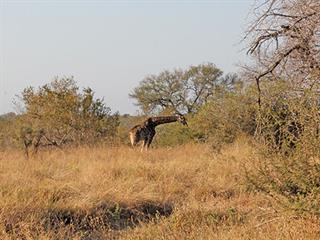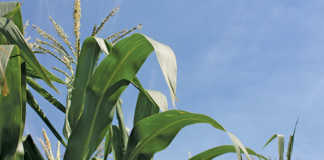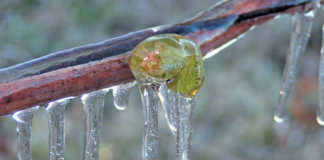
Just like humans, herbivorous animals have food preferences; certain groups of plants and plant species are chosen before others. Browser game species feed mostly on leaves and shoots of trees and shrubs (browse), while grazers prefer grasses and forbs. Mixed feeders come between these two groups. They include browse in their diet during winter and grass during summer, depending on availability.
Pure browsers include kudu, bushbuck, giraffe and black rhino, while mixed feeders include elephant, eland, impala, nyala, grey rhebuck and springbuck. Duiker, dik-dik, suni, grysbok and klipspringer are concentrate selectors of high-quality nutritious items, including browse.
Supplements
Browsing animals can supplement their diet with the sweeter things in life, such as small fruit, berries, seed pods and flowers of woody plants. Some browsers will bite off shoot ends, even when no leaves are present, and feed on woody seedlings.
Exotic plants such as poplar, blue gum and willow trees, and even prickly pear and cotoneaster, can be utilised seasonally.
Succulents, aloes, forbs, karroid shrubs and fallen leaf litter – especially of buffalo thorn – also provide important forage reserves.
Over-browsing
Browsing game species have such preference for certain plant species that some palatable trees may eventually be wiped out.
Generally, this happens when stocking densities are too high, resulting in overbrowsing. William Bond and Debbie Loffell of the University of Cape Town reported that in Ithala Reserve in KwaZulu-Natal, corky thorn trees have almost disappeared, and hook-thorn trees might follow the same route; while sweet thorn and paperbark thorn experienced high mortalities in areas heavily browsed by giraffe.
In the Kruger National Park, Benjamin Wigley of the Nelson Mandela Metropolitan University, among others, reported a decrease in African blackwood trees due to pressure from various browsers.In small game ranches in the Free State, browse lines (where all browse material has been removed up to a reachable height) are evident on specific tree species, and it has been observed that due to over-browsing, trees have taken on strange shapes.
Accessibility
In general, animals are always searching for the best food items to meet their requirements, and deciduous trees usually form the main component in a browsing animal’s diet. Deciduous trees such as sweet thorn, bluebush and buffalo thorn are the dominant tree species in the central Free State. This means that during winter, the browser’s main food source is leafless, and a period of browse shortage might occur if other food sources, such as evergreen plants and semi-deciduous shrubs (Asparagus laricinus, Lycium species), are not available.
When there were only standard farm fences in the Free State, antelope such as kudu and eland would jump these fences in winter to migrate to rocky hills or dense riverine vegetation in search of the food sources described above. Nowadays, game fences prevent these migrations, and it is therefore important to ensure that enough browse is available within the ranch.
Most browsing animals forage from ground level up to 2m, depending on their body size. Giraffe and elephant can reach up to 5m to feed.
Thus, the total browse capacity of the ranch will not be a true representation of the actual browse quantity that is available, since some browse is out of reach. To complicate matters further, there are other factors that influence availability of browse, including:
- A tree’s growth formthat results in certain parts of its canopy being out of reach;
- Bush thickening and encroachment that renders the inside of such a dense stand of trees inaccessible to browsers;
- Thorns that limit access to leaves and shoots;
- Competition between animals;
- Habitat choice that can exclude certain areas where browse is available from an animal’s home range.
Seasonal patterns
Beginning in 2006, Dr Beanélri Janecke a wildlife researcher at the University of the Free State, carried out research into the nitrogen quantity of browsing animals’ faeces on two ranches in the Free State, in order to determine if these animals on a small game ranch received enough nourishment from available browse. Dung was dried at room temperature, then in an oven and thereafter grounded to a powder that was loaded into a nitrogen analyser.
A seasonal pattern of the browsers’ faecal nitrogen was observed. It corresponded to leaf carriage patterns of deciduous trees, where the peak was reached in summer (when trees had full leaf carriage) and the lowest nitrogen values were documented during late winter (when deciduous trees are leafless and browse shortages usually occur).
Critical minimum nitrogen values are available in the research literature at which browsing animals lose condition or mortalities can occur. On one ranch, impala values dropped to this critical value due to an excess in their numbers, meaning competition for browse was high. During the period of browse shortage, faecal nitrogen of kudu dropped below this critical value and their condition loss was much more than usual during the winter. This happened only during a year when that particular game ranch was temporarily divided into two camps to separate new sable bulls, which prevented kudus from reaching the riverine vegetation.
This emphasises the importance of having different vegetation units – plains, rocky hills, river banks, drainage lines, open thickets – on a game ranch, especially in the Free State. Even inside a small game ranch (700ha), browsing animals migrate short distances seasonally to other vegetation types in search of forage resources, such as semi-deciduous shrubs, succulents and palatable evergreen plants that can sustain them through winter. A critical period of browse shortage usually occurs from the end of July to mid-September.
Therefore, it is essential to match the animal numbers with the actual available browse resources during winter, and not to the total summer browse capacity. Since there are numerous factors influencing availability of browse to animals even during the peak summer season, and because of the potential impact of browsing animals on plant species composition, it is a good rule of thumb to stock fewer animals than the total browse capacity calculated for a ranch.
Phone Dr Janecke on 051 401 9030 or email her at [email protected].













